![]()
![]()
![]()
Use LEFT and RIGHT arrow keys to navigate between flashcards;
Use UP and DOWN arrow keys to flip the card;
H to show hint;
A reads text to speech;
25 Cards in this Set
- Front
- Back
|
Tidal Volume |
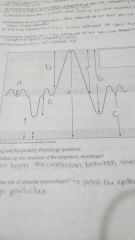
The amount of air you move into or out of your lungs during a single respiratory cycle 'label A' |
|
|
Expiratory Reserve volume (ERV) |
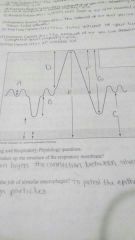
Amount of air you can voluntarily expel after you have completed on normal respiratory cycle 'labeled B' |
|
|
Residual volume |
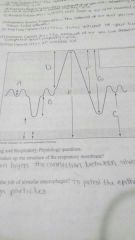
What's left over of the air after maximal exhalation 'labeled C' |
|
|
Inspiratory Reserve volume (IRV) |

The amount of air that you can take in over and above the title volume 'labeled D' |
|
|
Total lung capacity |
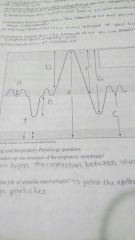
The total volume of your lungs 'labeled E' |
|
|
Inspiratory capacity |
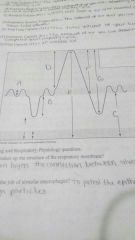
The amount of air you can draw into your lungs after completed quiet respiratory cycle 'labeled F' |
|
|
Vital capacity |

All usable air 'labeled G' |
|
|
What is the job of alveolar macrophages? |
To watch over the epithelium and engulf foreign particles |
|
|
What is the job of pneumocyte type 2? |
To produce surfactant |
|
|
What's the purpose of surfactant? |
It reduces surface tension and keeps alveoli from collapsing |
|
|
What is external respiration? |
The exchange of oxygen and carbon dioxide between interstitial fluid and external environment; includes pulmonary ventilation |
|
|
What is internal respiration? |
The exchange of oxygen and carbon dioxide between interstitial fluid and cells |
|
|
What is compliance of the lungs? |
The ability to be stretchable, descendible, and non collapsible. |
|
|
Low blood pH (below 7.35) 'high CO²' |
Acidosis |
|
|
High blood pH (above 7.45) 'Low CO²' |
Alkalosis |
|
|
What is diffusion |
It is the movement of gas molecules from a high concentration to a low concentration |
|
|
Which is more soluble oxygen or carbon dioxide |
CO² |
|
|
What does oxygen use to transport in the blood |
Hemoglobin |
|
|
Does more oxygen in the area mean there is a higher or lower partial pressure of oxygen? |
Higher partial pressure |
|
|
Higher partial pressure of oxygen means that ______ oxygen- hemoglobin saturation occurs |
More |
|
|
The "_____" of our body (majority are veins) contains just a little less of oxygen |
Blue blood |
|
|
Two major factors that increase lung compliance |
Elastic collagen and surfactant |
|
|
Pressure within the pleural cavity (in between the two layers) |
Intrapleural pressure |
|
|
Difference between intrapulmonary pressure and intrapleural pressure keeps alveoli open and flexible |
Transpulmonary pressure |
|
|
Pressure within the alveoli |
Intrapulmonary pressure |

